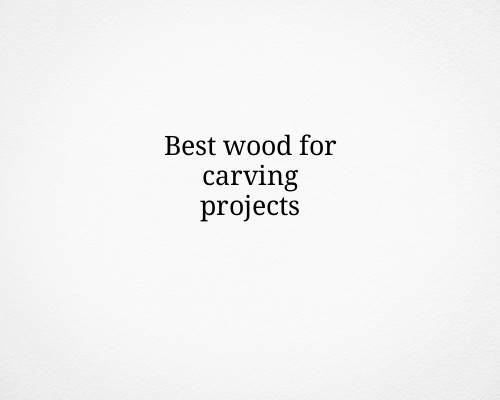When selecting the best wood for carving projects, it’s important to consider factors such as grain pattern, density, and ease of carving. Here are some of the top choices:
Basswood
- Pros: Basswood is widely considered the best wood for carving, especially for beginners. It’s lightweight, soft, and has a fine, consistent grain. This makes it easy to carve and shape with minimal effort.
- Cons: It can be soft enough to dent easily, so it may not hold intricate details as well as harder woods.
- Best for: Whittling, figurines, and detailed relief carving.
Butternut
- Pros: Butternut is another soft wood with a light color, similar to basswood. It has a smooth texture and is easy to carve, making it ideal for detailed work.
- Cons: Like basswood, it’s relatively soft and can be prone to damage.
- Best for: Intricate carvings, relief carvings, and decorative pieces.
Cherry
- Pros: Cherry wood is harder than basswood, but still carves well. It has a beautiful reddish-brown hue and darkens with age, adding character to carved pieces. It holds fine details and is durable.
- Cons: It’s harder to carve than basswood, so may require more effort.
- Best for: Detailed carvings, functional items like bowls or spoons, and furniture projects.
Maple
- Pros: Maple is a dense, strong hardwood that takes carving tools well. It has a fine, even grain that allows for smooth carving and holds details well.
- Cons: Maple can be tough to carve, especially for beginners, and may require sharper tools and more effort.
- Best for: Larger, more robust carving projects like furniture, and when durability is a key factor.
Pine
- Pros: Pine is easy to carve, with a light color and visible grain patterns. It’s generally inexpensive and widely available.
- Cons: It’s soft and can have knots that may complicate carving. Pine also doesn’t hold fine details as well as hardwoods.
- Best for: Larger, rustic carvings or simple whittling projects.
Walnut
- Pros: Walnut is a dense hardwood with a rich, dark color. It carves well and holds fine details, making it ideal for high-quality carving projects.
- Cons: It’s harder to carve compared to softer woods and can be expensive.
- Best for: Fine detail work, high-end projects, and carving intricate designs.
Cedar
- Pros: Cedar is a softwood that’s easy to carve and has a pleasant scent. It’s often used for smaller projects, especially in whittling.
- Cons: It can be too soft for holding fine details and may not be as durable over time.
- Best for: Small carvings, decorative items, and functional pieces like coasters.
Red Oak
- Pros: Red oak is a dense and durable hardwood that takes carving tools well. It has a pronounced grain that adds texture to carved pieces.
- Cons: Its coarse grain can make detailed carving challenging. It can also be tough to carve for beginners.
- Best for: Large carvings and projects where durability is important.
Final Thoughts: For beginners, basswood and butternut are the easiest to work with, offering smooth carvings with minimal effort. For more experienced carvers, woods like cherry, maple, and walnut provide durability and the ability to hold fine details. Ultimately, the best wood depends on the type of carving you plan to do and the tools you have available.
If you’re looking to dive deeper into woodworking projects, Ted’s Woodworking Course is a great resource that can guide you through more advanced techniques and ideas. Check it out here: Ted’s Woodworking Course
